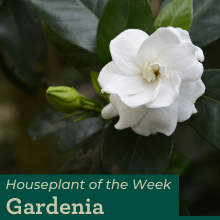 Although it is more commonly a fabulous fragrant shrub in your garden, it is possible to cultivate Gardenias as an indoor plant. But regardless of whether you have it inside or outside your home, this beauty requires a little bit of protective behavior on your part.
Although it is more commonly a fabulous fragrant shrub in your garden, it is possible to cultivate Gardenias as an indoor plant. But regardless of whether you have it inside or outside your home, this beauty requires a little bit of protective behavior on your part.
Why? Because Gardenias tend to be susceptible to all manners of pests. But if you can manage that (and it really isn’t that hard), it’s certainly worth it.
With it’s dark waxy leaves and snow white flower, Gardenias are handsome houseplants, but let’s face it – it’s that phenomenal perfume that is their real calling card. Which is part of what makes them such fabulous indoor plants; imagine being able to move them around to wherever you are so you can enjoy that captivating scent?
Caring for Your Gardenia
Let’s get the basics done before we talk about pests:
- Light: Gardenias love bright light, but avoid direct sunlight, especially during summer.
- Water: Keep your Gardenia moist, but reduce watering in the winter.
- Temperature: They love their heat. Please no indoor temps lower than 60 degrees. Keep out of the way of cold drafts.
- Soil: Most potting soils will do, but know that Gardenias prefer slightly acidic soil, so a non-alkaline mix is best.
- Fertilizer: Feed every couple of weeks with a non-alkaline fertilizer. If you want to lower the pH level in the soil, a teaspoon of agricultural sulfur will do the trick.
Okay, now about those pests. Mealybugs can be a problem, but what you really want to avoid is aphids, those nasty suckers that cluster below the leaves. Not only are they awful by themselves, they can also cause a secondary blight called sooty mold, which turns the leaves black. That in itself won’t kill the plant, but it keeps the plant from being able to absorb sunlight through its leaves, which in turns inhibits photosynthesis.
Fortunately, sooty mold is caused by the honeydew excreted by aphids, so if you control the aphids, you prevent sooty mold. Your best bet is neem oil. It will kill some pests, like mealybugs, on contact. It also attacks the larvae of other insects and repels pests feeding on plants because it has a bitter taste.
Repotting Your Gardenia
You should repot your gardenia every couple of years in the spring. If it isn’t as healthy as it had been, but you find no insects or diseases, it usually indicates that it needs to be repotted. Again, use a low-pH (non-alkaline) soil.